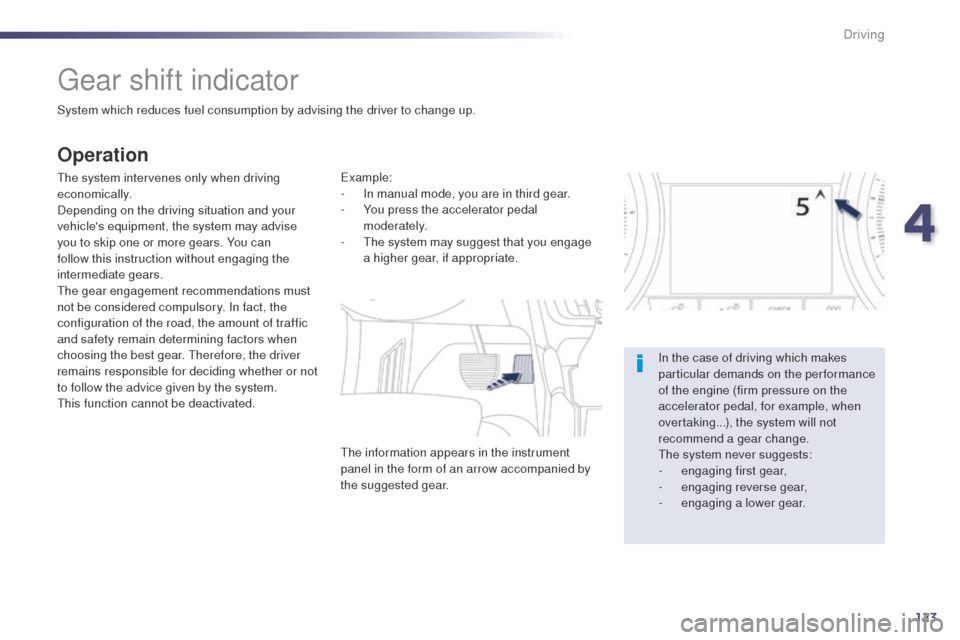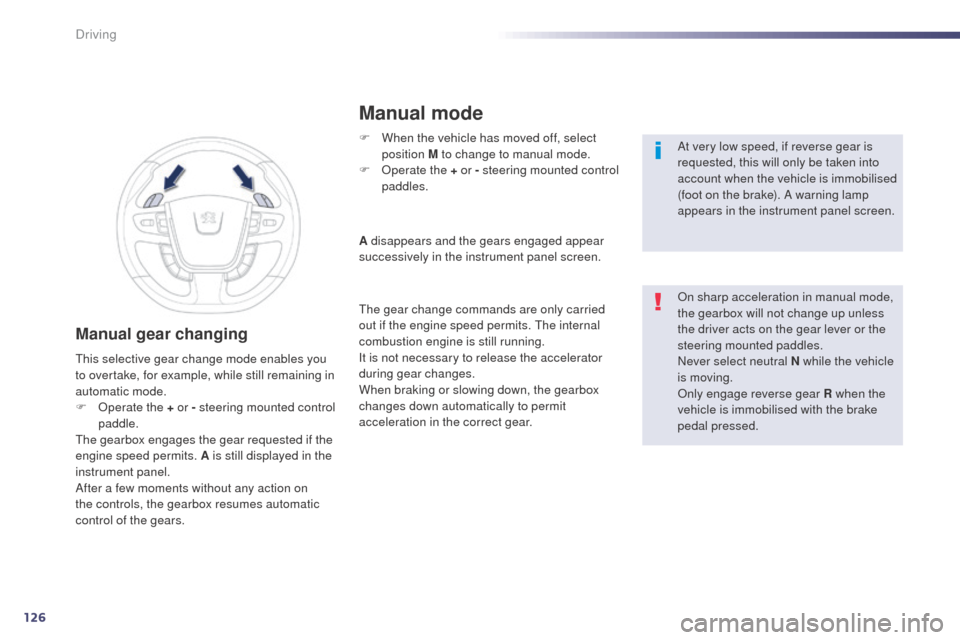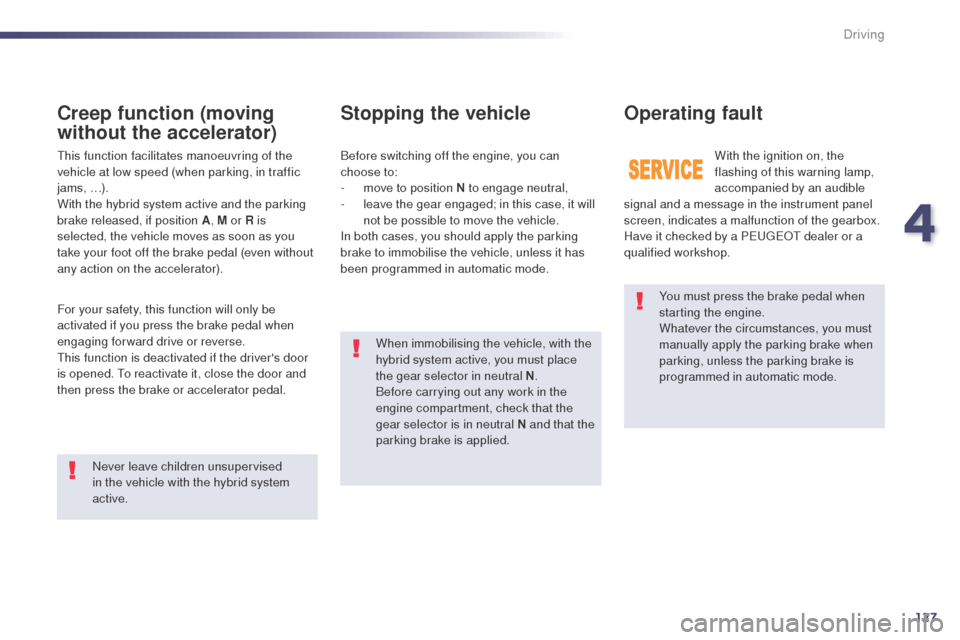2014 Peugeot 508 RXH engine
[x] Cancel search: enginePage 124 of 338

122
508RXH_en_Chap04_conduite_ed01-2014
SituationsConsequences
to a
pply the electric parking brake:
F
i
mmobilise the vehicle and switch off the ignition.
F
p
ull the control for at least 5 seconds or until application is complete.
F
s
witch on the ignition and check that the electric parking brake
warning lamps come on.
th
e application is slower than during normal operation.
to r
elease the electric parking brake:
F
s
witch on the ignition.
F
p
ush the control lever and hold it for approximately 3 seconds then
release it.
If the braking warning lamp is flashing or if the warning lamps do not
come on with the ignition on, these procedures will not work. Place the
vehicle on level ground and have it checked by a P
e
uge
Ot
dealer or a
qualified workshop.
and possibly
flashing
Display of the message "
Parking brake fault" and of the following
warning lamps: -
O
nly the automatic application on switching off the engine and
automatic release on acceleration functions are available.
-
t
h
e manual application/release of the electric parking brake and the
emergency braking are not available.
and possibly
flashing
Display of the message " Battery charge fault". -
Y
ou must stop as soon as it is safe to do so. Switch off and
immobilise your vehicle (if necessary, place the a chock under a
wheel).
-
A
pply the electric parking brake before switching off the engine.
Driving
Page 125 of 338

123
508RXH_en_Chap04_conduite_ed01-2014
gear shift indicator
System which reduces fuel consumption by advising the driver to change up.
Operation
the system intervenes only when driving
economically.
Depending on the driving situation and your
vehicle's equipment, the system may advise
you to skip one or more gears. You can
follow this instruction without engaging the
intermediate gears.
the
gear engagement recommendations must
not be considered compulsory. In fact, the
configuration of the road, the amount of traffic
and safety remain determining factors when
choosing the best gear.
t
her
efore, the driver
remains responsible for deciding whether or not
to follow the advice given by the system.
th
is function cannot be deactivated.ex ample:
- I n manual mode, you are in third gear.
-
Y
ou press the accelerator pedal
moderately.
-
t
h
e system may suggest that you engage
a higher gear, if appropriate.
th
e information appears in the instrument
panel in the form of an arrow accompanied by
the suggested gear. In the case of driving which makes
particular demands on the performance
of the engine (firm pressure on the
accelerator pedal, for example, when
overtaking...), the system will not
recommend a gear change.
th
e system never suggests:
-
e
ngaging first gear,
-
enga
ging reverse gear,
-
enga
ging a lower gear.
4
Driving
Page 127 of 338

125
508RXH_en_Chap04_conduite_ed01-2014
engagement of reverse gear is
accompanied by an audible signal.
If you leave the vehicle, place the gear
selector in position N and then you must
stop the hybrid system by switching off
the ignition ( Ready lamp off). If the engine does not start:
-
If
N is flashing in the instrument
panel, move the gear selector to
position A then to position N .
-
I
f the message "Foot on brake" is
displayed, press the brake pedal
f i r m l y.
For optimum acceleration, for example
when overtaking another vehicle, press
the accelerator pedal firmly past the
point of resistance.
Displays in the instrument panel
N Neutral
R Reverse
1, 2, 3, 4, 5, 6
g
e
ars in manual mode
A
t
h
is comes on when automated mode is
selected. It goes off on changing to manual
mode.
F
P
lace your foot on the brake
when a message appears in the
instrument panel screen.
Moving off
F Select a drive mode (position M or A ) or
reverse (position R ).
F
R
elease the parking brake by pulling the
control lever, if automatic operation has
been deactivated.
F
P
rogressively release the brake pedal.
F
I
f the parking brake is released, the vehicle
moves off.
I
f the parking brake is applied and
automatic mode is activated, accelerate
progressively.
A and 1 or R appear in the instrument
panel screen.
Automatic mode
A appears in the instrument panel screen.
the gearbox is then operating in auto-active
mode, without any action on the part of the
driver. It continuously selects the most suitable
gear, depending on the:
-
s
tyle of driving,
-
p
rofile of the road.
F
t
o s
tart the engine, place the gear selector
in position N .
F
P
ress the brake pedal down fully.
F
S
tart the hybrid system.
F
A
fter starting the vehicle, select position A
for enter automatic mode.
4
Driving
Page 128 of 338

126
508RXH_en_Chap04_conduite_ed01-2014
Manual gear changing
F When the vehicle has moved off, select position M to change to manual mode.
F
O
perate the + or - steering mounted control
paddles. At very low speed, if reverse gear is
requested, this will only be taken into
account when the vehicle is immobilised
(foot on the brake). A warning lamp
appears in the instrument panel screen.
On sharp acceleration in manual mode,
the gearbox will not change up unless
the driver acts on the gear lever or the
steering mounted paddles.
Never select neutral N while the vehicle
is moving.
Only engage reverse gear R when the
vehicle is immobilised with the brake
pedal pressed.
A disappears and the gears engaged appear
successively in the instrument panel screen.
th
e gear change commands are only carried
out if the engine speed permits.
t
h
e internal
combustion engine is still running.
It is not necessary to release the accelerator
during gear changes.
When braking or slowing down, the gearbox
changes down automatically to permit
acceleration in the correct gear.
th
is selective gear change mode enables you
to overtake, for example, while still remaining in
automatic mode.
F
O
perate the + or - steering mounted control
paddle.
th
e gearbox engages the gear requested if the
engine speed permits. A is still displayed in the
instrument panel.
After a few moments without any action on
the controls, the gearbox resumes automatic
control of the gears.
Manual mode
Driving
Page 129 of 338

127
508RXH_en_Chap04_conduite_ed01-2014
You must press the brake pedal when
starting the engine.
Whatever the circumstances, you must
manually apply the parking brake when
parking, unless the parking brake is
programmed in automatic mode.
When immobilising the vehicle, with the
hybrid system active, you must place
the gear selector in neutral N
.
Before carrying out any work in the
engine compartment, check that the
gear selector is in neutral N and that the
parking brake is applied.
Stopping the vehicle
With the ignition on, the
flashing of this warning lamp,
accompanied by an audible
signal and a message in the instrument panel
screen, indicates a malfunction of the gearbox.
Have it checked by a P
e
uge
Ot
dealer or a
qualified workshop.
Before switching off the engine, you can
choose to:
-
m
ove to position N to engage neutral,
-
l
eave the gear engaged; in this case, it will
not be possible to move the vehicle.
In both cases, you should apply the parking
brake to immobilise the vehicle, unless it has
been programmed in automatic mode.
Operating fault
this function facilitates manoeuvring of the
vehicle at low speed (when parking, in traffic
jams, …).
With the hybrid system active and the parking
brake released, if position A , M or R is
selected, the vehicle moves as soon as you
take your foot off the brake pedal (even without
any action on the accelerator).
Creep function (moving
without the accelerator)
Never leave children unsupervised
in the vehicle with the hybrid system
active.
For your safety, this function will only be
activated if you press the brake pedal when
engaging forward drive or reverse.
th
is function is deactivated if the driver's door
is opened. t
o r
eactivate it, close the door and
then press the brake or accelerator pedal.
4
Driving
Page 132 of 338

130
508RXH_en_Chap04_conduite_ed01-2014
F With the engine running, press button 1 to activate the system and deploy the strip.
F
P
ress and hold button 2 to deactivate the
system and retract the strip.
th
e activated/deactivated state is saved and
restored on restarting the engine.
Activation / Deactivation
F With the engine running, adjust the brightness of the information displayed
using buttons 3 :
-
t
he "sun" to increase the brightness,
-
t
he "moon" to decrease the brightness.
Brightness adjustment
We recommend that adjustments are made
using these buttons only when the vehicle
is stationary.
When stationary or while driving, no objects
should be placed around the strip (or in its
recess) so as to not impede deployment of
the strip and its correct operation.
In certain extreme weather conditions
(rain and/or snow, bright sunshine, ...)
the head-up display may not be legible
or may suffer temporary interference.
Some sunglasses may hamper reading
of the information.
to c
lean the strip, use a clean, soft
cloth (such as a spectacles cloth or
microfibre cloth). Do not use a dry or
abrasive cloth or detergent or solvent
products as these could scratch the
strip or damage the non-reflective
coating.
Height adjustment
F With the engine running, adjust the display to the desired height using buttons 4 :
-
u
p to move the display up,
-
d
own to move the display down.
Driving
Page 134 of 338

132
508RXH_en_Chap04_conduite_ed01-2014
No alert will be given in the following situations:
- i n the presence of stationary objects
(parked vehicles, barriers, street lamps,
road signs...),
-
w
ith vehicles moving in the opposite
direction,
-
d
riving on a sinuous road or a sharp
c o r n e r,
Operation
F On switching on the ignition, or engine running, press this button
to activate the function; the
warning lamp comes on. Sensors fitted in the front and rear bumpers
monitor the blind spots.
th
e alert is given by a warning lamp which
comes on in the door mirror on the side in
question as soon as a vehicle - car, lorry,
cycle - is detected and the following conditions
are fulfilled:
-
a
ll the vehicles must be moving in the
same direction,
-
t
he speed of your vehicle is between 7 and
75 mph (12 and 140 km/h),
- t he difference in speed between your
vehicle and the other vehicles must be less
than 6 mph (10 km/h),
-
t
he traffic must be flowing normally,
-
i
n the case of an overtaking manoeuvre,
if this is prolonged and the vehicle being
overtaken remains in the blind spot,
-
y
ou are driving on a straight or slightly
curved road,
-
y
our vehicle is not pulling a trailer, a
caravan...
Driving
Page 147 of 338

145
508RXH_en_Chap05_visibilite_ed01-2014
Lighting left on audible signal
An audible signal when a front door
is opened warns the driver that the
vehicle's exterior lighting is on, with the
ignition off and in manual lighting mode.
In this case, switching off the lighting
stops the audible signal.
With the ignition off, if the dipped
headlamps remain on, the vehicle goes
into "
eC
O" mode to avoid discharging
the battery.
In some weather conditions (e.g. low
temperature or humidity), the presence
of misting on the internal sur face of the
glass of the headlamps and rear lamps
is normal; it disappears after the lamps
have been on for a few minutes. Daytime lighting, compulsory in certain
countries, which comes on automatically when
the engine is started making the vehicle more
visible to other road users.
Daytime running lamps
this function is assured:
-
i n countries where it is imposed by
regulations, by illumination of the dipped
beam headlamps with the sidelamps and
number plate lamps.
-
f
or other countries where it is provided, by
the use of dedicated lamps.
th
e lighting goes off when you switch
off the ignition, but you can always
switch it on again using the lighting
control stalk.
*
f
unction that can be set in the vehicle
configuration menu.
LED lamps
they come on when the engine is started.
Depending on the destination country, they are
used for:
-
d
aytime running lamps* in day mode and
sidelamps in night mode (they are brighter
when daytime running lamps),
or
-
s
idelamps in day and night mode.
Where L
eD l
amps are fitted, the filament bulbs
for the daytime running lamps / sidelamps in
the front lamp units are not used.
5
Visibility